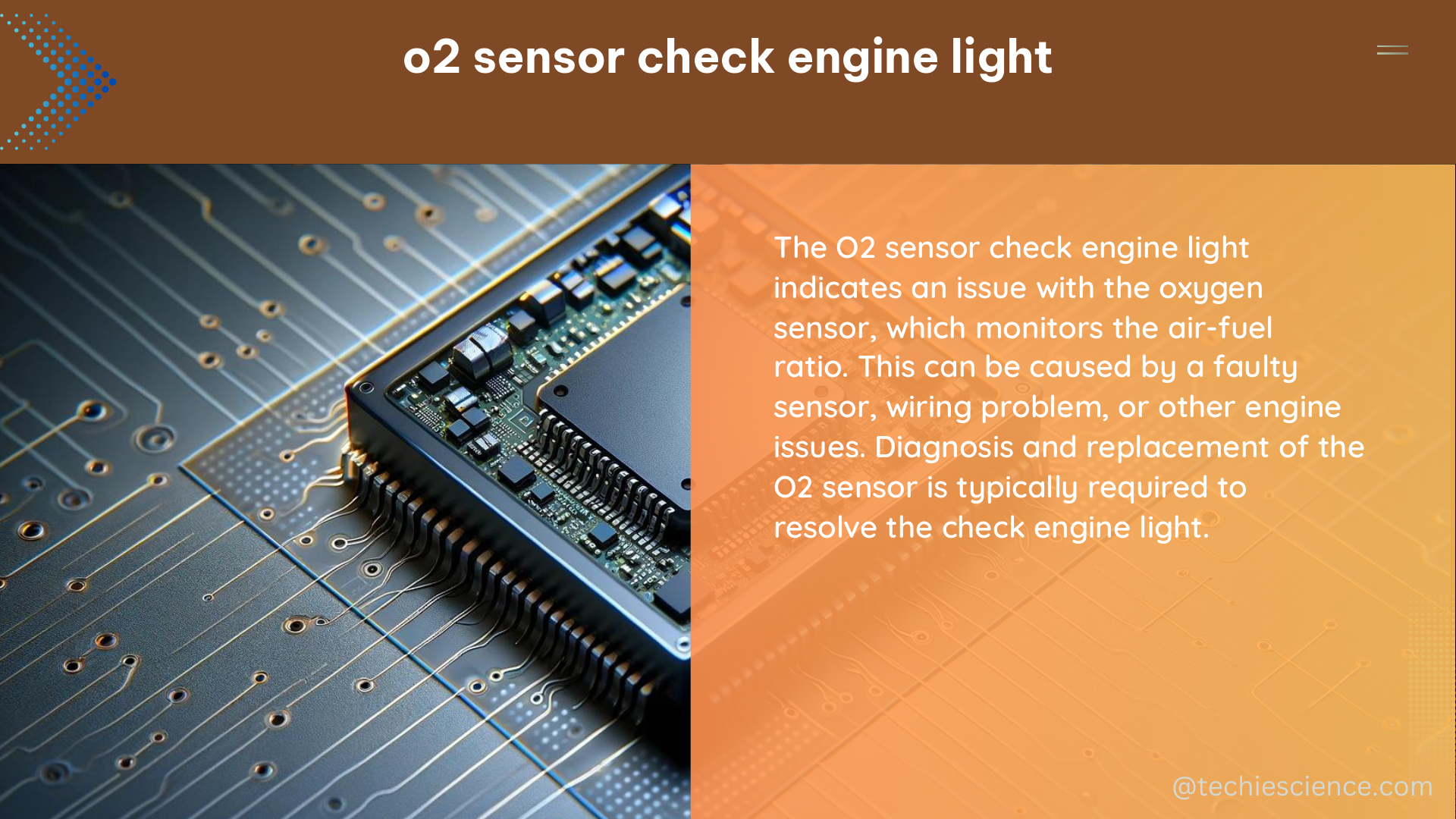The O2 sensor, also known as the oxygen sensor, is a critical component in the engine management system of modern vehicles. It plays a crucial role in monitoring the air-fuel ratio and ensuring optimal engine performance, fuel efficiency, and emissions control. When the O2 sensor malfunctions, it can trigger the dreaded check engine light, signaling a problem that requires immediate attention.
Understanding the Role of O2 Sensors
O2 sensors are strategically placed in the exhaust system, typically before and after the catalytic converter. Their primary function is to measure the oxygen content in the exhaust gases and provide this information to the engine control unit (ECU). The ECU then uses this data to adjust the air-fuel mixture, ensuring complete combustion and minimizing harmful emissions.
There are typically four O2 sensors in a standard vehicle, with two sensors located upstream (before) the catalytic converter and two sensors downstream (after) the catalytic converter. The upstream sensors monitor the air-fuel mixture, while the downstream sensors assess the efficiency of the catalytic converter in reducing emissions.
Diagnosing O2 Sensor-Related Check Engine Lights

When the check engine light illuminates due to an O2 sensor issue, it is essential to retrieve the specific OBD-II diagnostic trouble code (DTC) to identify the problem. Some common O2 sensor-related DTCs include:
| DTC Code | Description |
|---|---|
| P0031 | Oxygen Sensor Heater Circuit Low Voltage (Bank 1, Sensor 1) |
| P0036 | Oxygen Sensor Heater Circuit Low Voltage (Bank 1, Sensor 2) |
| P0041 | Oxygen Sensor Signal Stuck Lean (Bank 1, Sensor 2) |
| P0046 | Oxygen Sensor Heater Performance (Bank 1, Sensor 2) |
These codes provide valuable information about the specific sensor and the nature of the problem, whether it’s a heater circuit issue, a performance problem, or a signal-related fault.
Replacing O2 Sensors
Once the problematic O2 sensor has been identified, the next step is to replace it with a high-quality, OE-recommended sensor. Denso and NTK are two reputable brands that are widely used and available on platforms like RockAuto.
When replacing an O2 sensor, it’s crucial to follow the manufacturer’s instructions carefully. This includes ensuring proper sensor orientation, tightening the sensor to the specified torque, and avoiding damage to the sensor’s delicate components. Improper installation can lead to further issues and potentially cause additional damage to the engine management system.
Clearing the Check Engine Light
After replacing the faulty O2 sensor, the check engine light may not immediately turn off. This is because the ECU needs to verify the repair and confirm that the new sensor is functioning correctly. To clear the check engine light, it is often necessary to perform a drive cycle, which involves driving the vehicle under specific conditions to allow the ECU to complete its diagnostic routines.
The exact drive cycle procedure may vary depending on the vehicle make and model, but it typically involves the following steps:
- Start the engine and let it idle for 2-3 minutes.
- Drive the vehicle at a constant speed of 45-55 mph for at least 10 minutes.
- Accelerate the vehicle to 55-65 mph and maintain that speed for at least 5 minutes.
- Decelerate the vehicle to a stop, allowing the engine to idle for 2-3 minutes.
- Repeat steps 2-4 at least once.
In some cases, disconnecting the battery terminals for a short period (30 minutes to an hour) may also help reset the ECU and clear the check engine light. However, it is generally recommended to use a diagnostic scan tool to clear the code and confirm that the repair has been successful.
Preventing Future O2 Sensor Issues
To proactively maintain the health of your vehicle’s O2 sensors and prevent future check engine light issues, consider the following tips:
- Regular Maintenance: Follow the manufacturer’s recommended maintenance schedule, which may include periodic replacement of the O2 sensors.
- Fuel Quality: Use high-quality, recommended fuel to avoid contaminants that can damage the O2 sensors over time.
- Driving Habits: Avoid excessive idling, sudden acceleration, and other driving behaviors that can strain the engine and the O2 sensor system.
- Timely Repairs: Address any check engine light issues promptly to prevent further damage and ensure optimal engine performance.
By understanding the critical role of O2 sensors and following best practices for their maintenance and replacement, you can keep your vehicle running smoothly and avoid the frustration of a persistent check engine light.
References:
- YouTube Video: Diagnosing and Replacing an O2 Sensor
- Odyclub Forum: Check Engine Light – O2 Sensor
- Acurazine Forum: Check Engine Light – O2 Sensor
- AutoLab USA: Check Engine Light On? Could Be a Faulty O2 Sensor
- Reddit: Getting Rid of Check Engine Light After Replacing O2 Sensor

The lambdageeks.com Core SME Team is a group of experienced subject matter experts from diverse scientific and technical fields including Physics, Chemistry, Technology,Electronics & Electrical Engineering, Automotive, Mechanical Engineering. Our team collaborates to create high-quality, well-researched articles on a wide range of science and technology topics for the lambdageeks.com website.
All Our Senior SME are having more than 7 Years of experience in the respective fields . They are either Working Industry Professionals or assocaited With different Universities. Refer Our Authors Page to get to know About our Core SMEs.